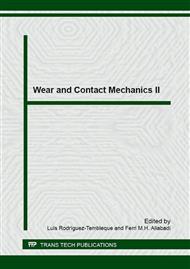p.47
p.86
p.100
p.117
p.142
p.155
p.175
p.185
p.197
Theoretical and Experimental Investigation on Friction in Lubricated Line Contacts with Different Materials and Textures in Presence of Wear
Abstract:
An experimental investigation on the friction coefficient in line contacts under mixed and boundary lubrication regimes is described. Rectangular contacts between cylindrical specimens and the flat surface of discs of different material and surface roughness combinations were analyzed. Very low Stribeck numbers have been considered, resulting also in low dimensionless film thickness, so that the morphology of the surfaces and the material had a remarking role. In this work, the theoretical procedure for assessing the friction coefficient in the tested cases is described and compared to experimental results. Additionally, wear effects obtained in boundary lubrication conditions are shown. The surface conditions are put in relation with some particular trends of the friction coefficient obtained for certain combinations of materials and roughness.
Info:
Periodical:
Pages:
142-154
Citation:
Online since:
February 2016
Authors:
Keywords:
Permissions:
Share:
Citation:


